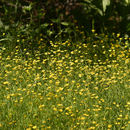Comments
(
Inglês
)
fornecido por eFloras
The seeds of Ranunculus occidentalis were eaten by some Californian Indians. D. E. Moerman (1986) identified this taxon as an Aleut poison: juice of the flowers could be slipped into food to poison the person who ate it.
- licença
- cc-by-nc-sa-3.0
- direitos autorais
- Missouri Botanical Garden, 4344 Shaw Boulevard, St. Louis, MO, 63110 USA
Description
(
Inglês
)
fornecido por eFloras
Stems erect to reclining, not rooting nodally, hirsute or sometimes pilose or glabrous, base not bulbous. Roots never tuberous. Basal leaf blades broadly ovate to semicircular or reniform in outline, 3-parted or -foliolate, 1.5-5.3 × 2.2-8 cm, segments usually again 1(-2)×-lobed, ultimate segments oblong or elliptic to lanceolate or oblanceolate, margins dentate (sometimes dentate-lobulate or entire), apex acute to rounded-obtuse. Flowers: receptacle glabrous; sepals reflexed 2-3 mm above base, 4-7(-9) × 2-4 mm, hirsute; petals 5-14, yellow, 5-13 × 1.5-8 mm. Heads of achenes hemispheric, 3-7 × 5-9 mm; achenes 2.6-3.6(-4.8) × 1.8-3(-3.2) mm, glabrous, rarely hispid, margin forming narrow rib 0.1-0.2 mm wide; beak persistent, lanceolate to lance-subulate, straight or curved, 0.4-2.2 mm.
- licença
- cc-by-nc-sa-3.0
- direitos autorais
- Missouri Botanical Garden, 4344 Shaw Boulevard, St. Louis, MO, 63110 USA

